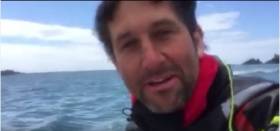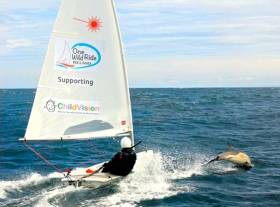Displaying items by tag: Gary Sargent
Being a maritime correspondent can be encouraging, disheartening and frustrating.
Preparing the current edition of THIS ISLAND NATION I experienced those emotions.
I heard a sailor praise the coastal communities he had met during a 42-day voyage around Ireland. He described them as the “most wonderful people who are essential to this island nation.”
I also talked to a fisherman, trying to ensure the future of his community, describe the dismissive, discourteous attitude of State agencies.
I stood at the evocative memorial to those lost at sea in Dunmore East fishing port in County Waterford, where a fisherman pointed out to me the names of those of his family who had died in marine tragedies. He told me that visitors to coastal areas wanted to see fishing boats, not yachts at marinas.
I was the only journalist on the pier at Schull in West Cork on Saturday afternoon when Gary Sargent completed his ‘one wild ride’ on a Laser around Ireland. The general media didn’t show much interest..
Gary learned a lot about coastal communities during his voyage, which started an ended at Schull in West Cork: “They are wonderful people who commit themselves to helping you. It was an eye-opener, a lesson for me, from Dublin, showing me how vital these communities are to this island nation. We are blessed with wonderful coastal people, whom we should respect and value. We have an amazing coastline and eco system that we should get out and see more of. I have learned so much about respecting the water.”
On his voyage, he capsized four times. “It was mentally harder than physically. There was the challenge of getting into the boat in a wet suit every day, no matter what the weather and no matter how I felt.”
• Listen to Gary describe his voyage on the programme below and about the garden mats which were a vital part of his equipment
I interviewed Sean Doherty, a fisherman from Cheekpoint on the Suir Estuary who told me that he fears children in coastal communities will not know the history or heritage of their communities which are being destroyed by Government neglect, he said. His interview is a salutary contrast to what Gary Sargent experienced amongst the coastal communities. Sean Doherty outlines how his community put a lot of time and effort into submitting plans for the future of their communities, but after a year of waiting for response, they have heard nothing.
That is unacceptable and appears to indicate a dismissive attitude towards coastal communities.
• Listen to Sean Doherty on the programme
Also in the past week, the latest figure for the value of catches which European Union fishing nations, other than Ireland, take from Irish waters every year was put at €4 billion by the Irish Fish Producers’ Organisation That is a huge loss to the Irish economy and is a transfer of wealth from Ireland, an effective contribution to the EU about which very little has ever been said in public by the Government or the national media.
At the same time there is a lot of political mouthing and posturing about our Ocean Wealth. Is it any wonder I get frustrated at times?
After 36 sailing days behind him, Gary 'Ted Sargent' the Dublin single handed Laser sailor passed his final headland last night at Baltimore in West Cork and will arrive back at his starting point in Schull at 1pm today. It all got a bit emotional for the solo helmsman who makes a last minute appeal for donations for his Childvision charity below.
Laser Round Ireland Charity Bid Well On Track
Dublin sailor Gary “Ted” Sargent’s project to sail clockwise from Schull round Ireland in a Laser is well past the halfway stage, as today he is battling with light winds in the approaches to Ardglass in County Down writes W M Nixon.
The challenge, aimed at raising funds for the charity ChildVision which is dedicated to the education and therapy needs of blind and multi-disabled children, is being undertaken with a high degree of safety awareness - he is accompanied by a RIB with a shore support team. But even so, in a boat as small as a Laser, it can be a long and lonely voyage.
Ted departed from Schull on May 14th, taking on the Big One – the West Coast – almost immediately, as he cheerfully admitted that otherwise it would seem to appear bigger and even more brutal if he left it until the latter half of his circumnavigation.
But in terms of fair winds and reasonable sailing, while the West Coast may not have been a great big pussy cat, it certainly provided fast and efficient passage-making. However, since then he has found the north and east coasts increasingly frustrating with light winds and unavoidable strong to very tides all the way from Malin Head through the North Channel to the South Rock off the County Down coast.
But today, more than four weeks after leaving Schull, the South Rock has finally been put astern, and he’ll have normal tides until he’s in the area of Skerries. But quite when that will be remains to be seen – sailing round Ireland is something very different when you’re in a boat the size of a couple of bathtubs rather than one with which you’d be allowed to do the Volvo Round Ireland Race. Get the full story here
#OneWildRide - Schull sailor Gary Sargent aims to be the first to round Ireland in a Laser dinghy when he embarks on his charity voyage within the next fortnight.
As previously noted on Afloat.ie, the Howth Yacht Club member and Frostbite competitor is "undertaking the mammoth task of sailing a Laser around Ireland" this summer.
And as The Irish Times reports, 'Ted' hopes to raise funds during his eight-week, 1,500km solo circumnavigation for ChildVision, a charity supporting children with visual impairments and related disabilities.
While he's sailing alone on his Laser on his One Wild Ride, he will have the support of a RIB and volunteers on shore following him along the route with necessary supplies.
Even so, Sargent's been battling the elements – and the unseasonable cold – on his long-distance training runs, proving that he's no pretender for this challenging task.
The Irish Times has more in the story HERE.































































